Management Accounting Assignment 1: ABB Suitability Analysis
VerifiedAdded on 2023/06/05
|15
|4051
|226
Report
AI Summary
This report assesses the suitability of Activity Based Budgeting (ABB) for a manufacturing firm. It begins with an introduction to budgeting and its importance, followed by a description of the firm and the concept of ABB. The report then compares ABB with traditional budgeting, highlighting key differences such as the focus on activities versus functions and cost drivers versus departmental costs. The analysis evaluates ABB's suitability for the firm, emphasizing its potential to enhance efficiency, competitive advantage, customer relationships, and operational requirements. The report concludes with recommendations regarding the implementation of ABB within the organization, providing a comprehensive overview of ABB's benefits and drawbacks in a financial context.

Management Accounting Assignment 1
MANAGEMENT ACCOUNTING ASSIGNMENT
Author
Course
Professor
City
Date
MANAGEMENT ACCOUNTING ASSIGNMENT
Author
Course
Professor
City
Date
Paraphrase This Document
Need a fresh take? Get an instant paraphrase of this document with our AI Paraphraser
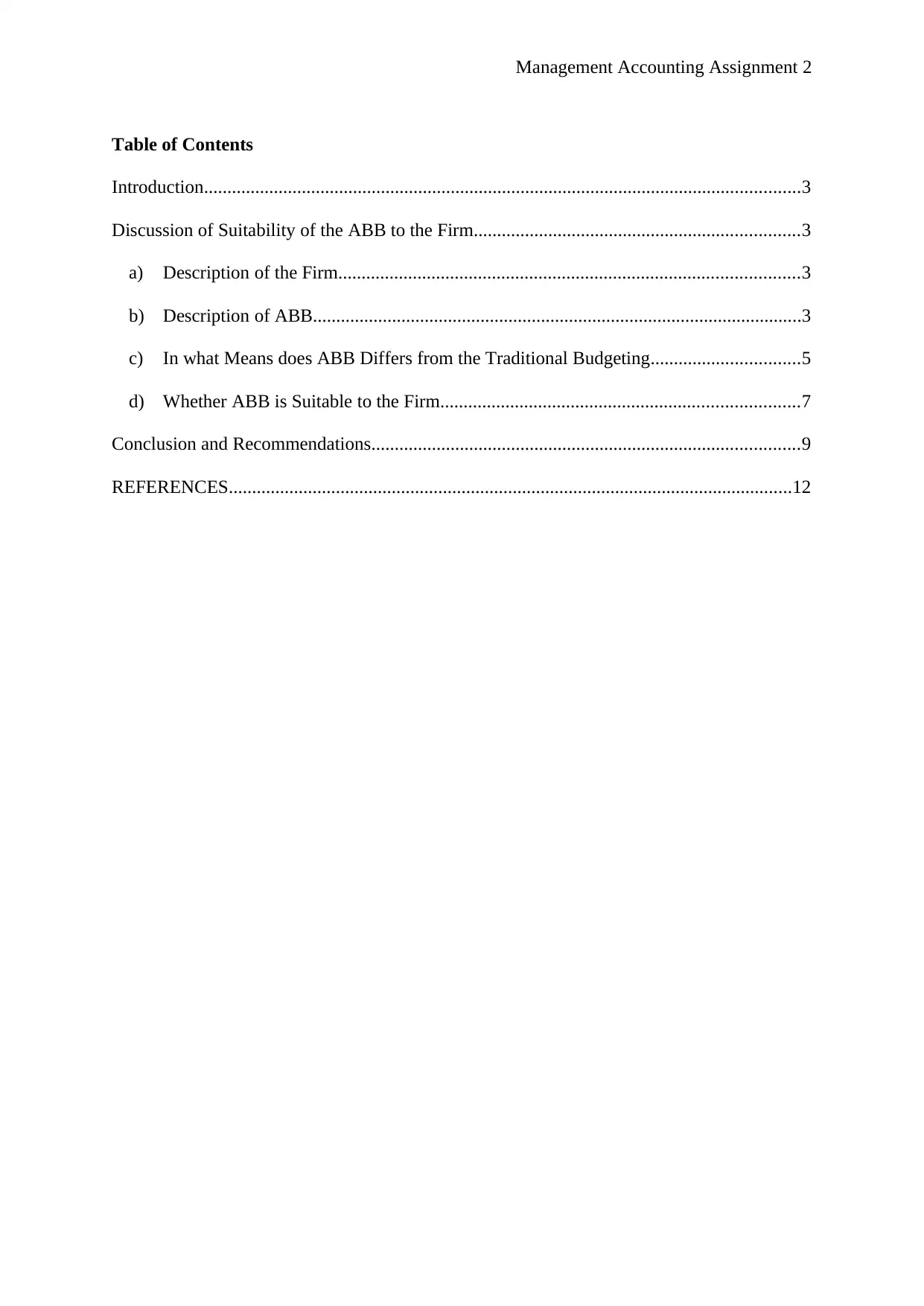
Management Accounting Assignment 2
Table of Contents
Introduction................................................................................................................................3
Discussion of Suitability of the ABB to the Firm......................................................................3
a) Description of the Firm...................................................................................................3
b) Description of ABB.........................................................................................................3
c) In what Means does ABB Differs from the Traditional Budgeting................................5
d) Whether ABB is Suitable to the Firm.............................................................................7
Conclusion and Recommendations............................................................................................9
REFERENCES.........................................................................................................................12
Table of Contents
Introduction................................................................................................................................3
Discussion of Suitability of the ABB to the Firm......................................................................3
a) Description of the Firm...................................................................................................3
b) Description of ABB.........................................................................................................3
c) In what Means does ABB Differs from the Traditional Budgeting................................5
d) Whether ABB is Suitable to the Firm.............................................................................7
Conclusion and Recommendations............................................................................................9
REFERENCES.........................................................................................................................12
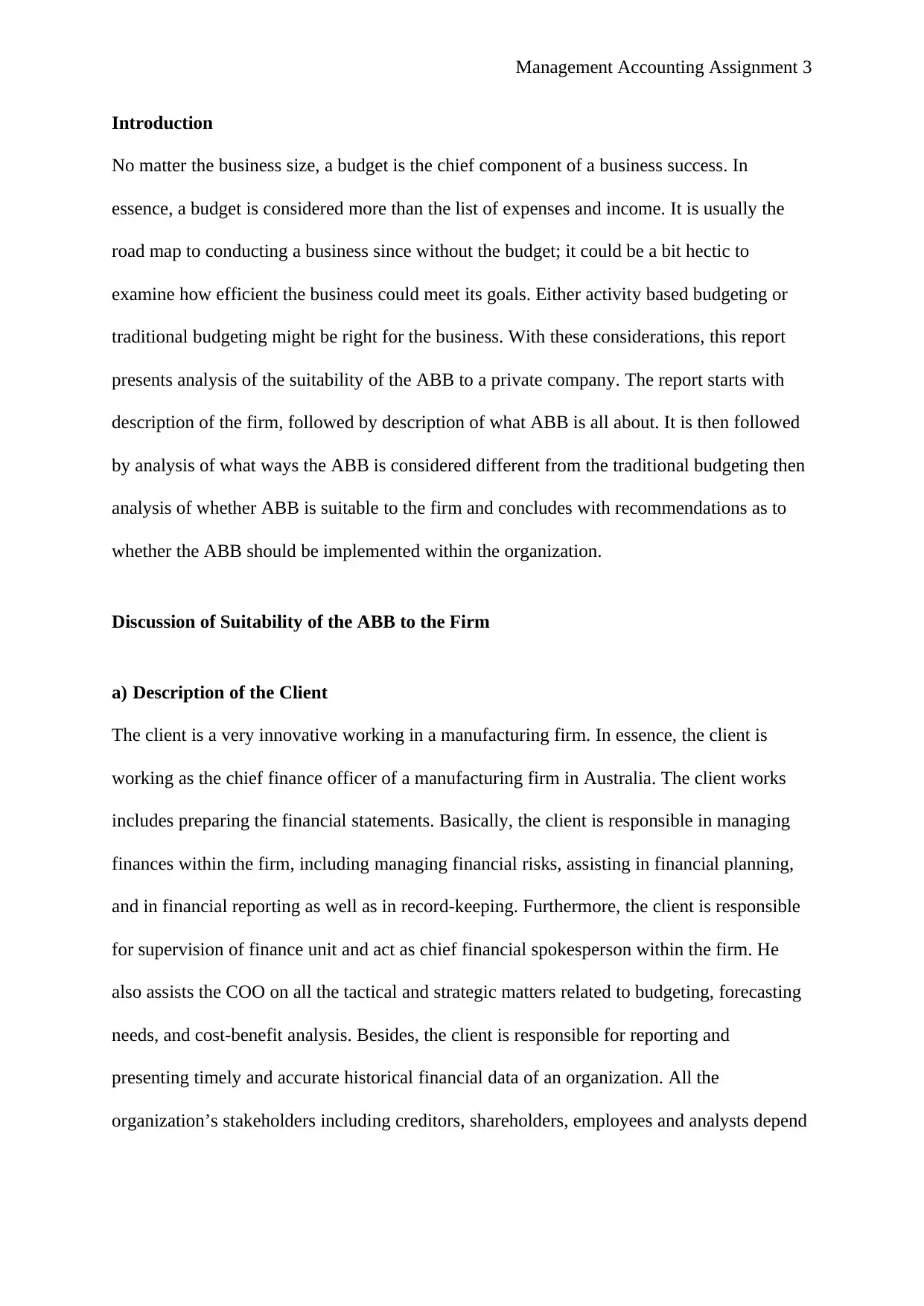
Management Accounting Assignment 3
Introduction
No matter the business size, a budget is the chief component of a business success. In
essence, a budget is considered more than the list of expenses and income. It is usually the
road map to conducting a business since without the budget; it could be a bit hectic to
examine how efficient the business could meet its goals. Either activity based budgeting or
traditional budgeting might be right for the business. With these considerations, this report
presents analysis of the suitability of the ABB to a private company. The report starts with
description of the firm, followed by description of what ABB is all about. It is then followed
by analysis of what ways the ABB is considered different from the traditional budgeting then
analysis of whether ABB is suitable to the firm and concludes with recommendations as to
whether the ABB should be implemented within the organization.
Discussion of Suitability of the ABB to the Firm
a) Description of the Client
The client is a very innovative working in a manufacturing firm. In essence, the client is
working as the chief finance officer of a manufacturing firm in Australia. The client works
includes preparing the financial statements. Basically, the client is responsible in managing
finances within the firm, including managing financial risks, assisting in financial planning,
and in financial reporting as well as in record-keeping. Furthermore, the client is responsible
for supervision of finance unit and act as chief financial spokesperson within the firm. He
also assists the COO on all the tactical and strategic matters related to budgeting, forecasting
needs, and cost-benefit analysis. Besides, the client is responsible for reporting and
presenting timely and accurate historical financial data of an organization. All the
organization’s stakeholders including creditors, shareholders, employees and analysts depend
Introduction
No matter the business size, a budget is the chief component of a business success. In
essence, a budget is considered more than the list of expenses and income. It is usually the
road map to conducting a business since without the budget; it could be a bit hectic to
examine how efficient the business could meet its goals. Either activity based budgeting or
traditional budgeting might be right for the business. With these considerations, this report
presents analysis of the suitability of the ABB to a private company. The report starts with
description of the firm, followed by description of what ABB is all about. It is then followed
by analysis of what ways the ABB is considered different from the traditional budgeting then
analysis of whether ABB is suitable to the firm and concludes with recommendations as to
whether the ABB should be implemented within the organization.
Discussion of Suitability of the ABB to the Firm
a) Description of the Client
The client is a very innovative working in a manufacturing firm. In essence, the client is
working as the chief finance officer of a manufacturing firm in Australia. The client works
includes preparing the financial statements. Basically, the client is responsible in managing
finances within the firm, including managing financial risks, assisting in financial planning,
and in financial reporting as well as in record-keeping. Furthermore, the client is responsible
for supervision of finance unit and act as chief financial spokesperson within the firm. He
also assists the COO on all the tactical and strategic matters related to budgeting, forecasting
needs, and cost-benefit analysis. Besides, the client is responsible for reporting and
presenting timely and accurate historical financial data of an organization. All the
organization’s stakeholders including creditors, shareholders, employees and analysts depend
⊘ This is a preview!⊘
Do you want full access?
Subscribe today to unlock all pages.

Trusted by 1+ million students worldwide
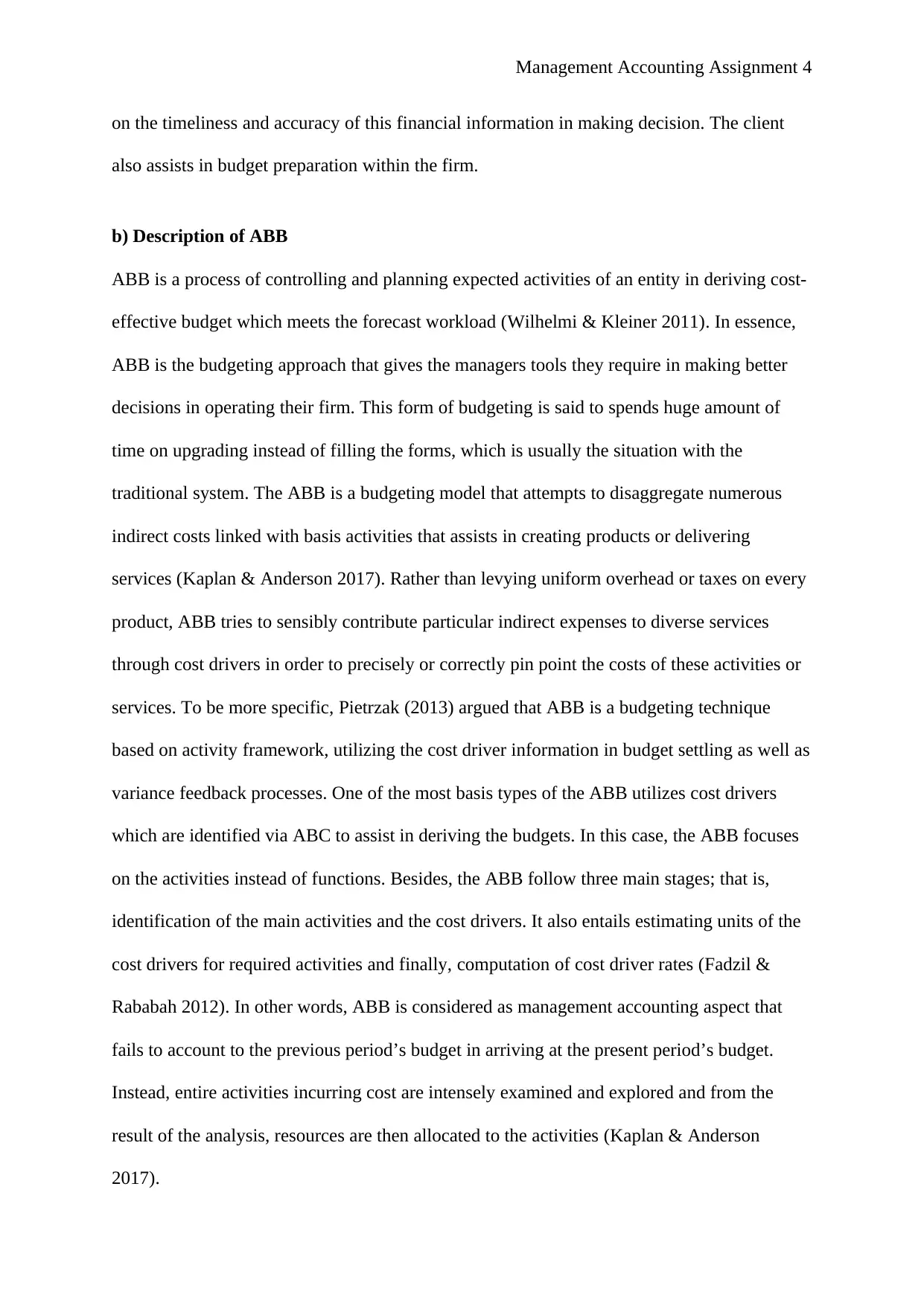
Management Accounting Assignment 4
on the timeliness and accuracy of this financial information in making decision. The client
also assists in budget preparation within the firm.
b) Description of ABB
ABB is a process of controlling and planning expected activities of an entity in deriving cost-
effective budget which meets the forecast workload (Wilhelmi & Kleiner 2011). In essence,
ABB is the budgeting approach that gives the managers tools they require in making better
decisions in operating their firm. This form of budgeting is said to spends huge amount of
time on upgrading instead of filling the forms, which is usually the situation with the
traditional system. The ABB is a budgeting model that attempts to disaggregate numerous
indirect costs linked with basis activities that assists in creating products or delivering
services (Kaplan & Anderson 2017). Rather than levying uniform overhead or taxes on every
product, ABB tries to sensibly contribute particular indirect expenses to diverse services
through cost drivers in order to precisely or correctly pin point the costs of these activities or
services. To be more specific, Pietrzak (2013) argued that ABB is a budgeting technique
based on activity framework, utilizing the cost driver information in budget settling as well as
variance feedback processes. One of the most basis types of the ABB utilizes cost drivers
which are identified via ABC to assist in deriving the budgets. In this case, the ABB focuses
on the activities instead of functions. Besides, the ABB follow three main stages; that is,
identification of the main activities and the cost drivers. It also entails estimating units of the
cost drivers for required activities and finally, computation of cost driver rates (Fadzil &
Rababah 2012). In other words, ABB is considered as management accounting aspect that
fails to account to the previous period’s budget in arriving at the present period’s budget.
Instead, entire activities incurring cost are intensely examined and explored and from the
result of the analysis, resources are then allocated to the activities (Kaplan & Anderson
2017).
on the timeliness and accuracy of this financial information in making decision. The client
also assists in budget preparation within the firm.
b) Description of ABB
ABB is a process of controlling and planning expected activities of an entity in deriving cost-
effective budget which meets the forecast workload (Wilhelmi & Kleiner 2011). In essence,
ABB is the budgeting approach that gives the managers tools they require in making better
decisions in operating their firm. This form of budgeting is said to spends huge amount of
time on upgrading instead of filling the forms, which is usually the situation with the
traditional system. The ABB is a budgeting model that attempts to disaggregate numerous
indirect costs linked with basis activities that assists in creating products or delivering
services (Kaplan & Anderson 2017). Rather than levying uniform overhead or taxes on every
product, ABB tries to sensibly contribute particular indirect expenses to diverse services
through cost drivers in order to precisely or correctly pin point the costs of these activities or
services. To be more specific, Pietrzak (2013) argued that ABB is a budgeting technique
based on activity framework, utilizing the cost driver information in budget settling as well as
variance feedback processes. One of the most basis types of the ABB utilizes cost drivers
which are identified via ABC to assist in deriving the budgets. In this case, the ABB focuses
on the activities instead of functions. Besides, the ABB follow three main stages; that is,
identification of the main activities and the cost drivers. It also entails estimating units of the
cost drivers for required activities and finally, computation of cost driver rates (Fadzil &
Rababah 2012). In other words, ABB is considered as management accounting aspect that
fails to account to the previous period’s budget in arriving at the present period’s budget.
Instead, entire activities incurring cost are intensely examined and explored and from the
result of the analysis, resources are then allocated to the activities (Kaplan & Anderson
2017).
Paraphrase This Document
Need a fresh take? Get an instant paraphrase of this document with our AI Paraphraser
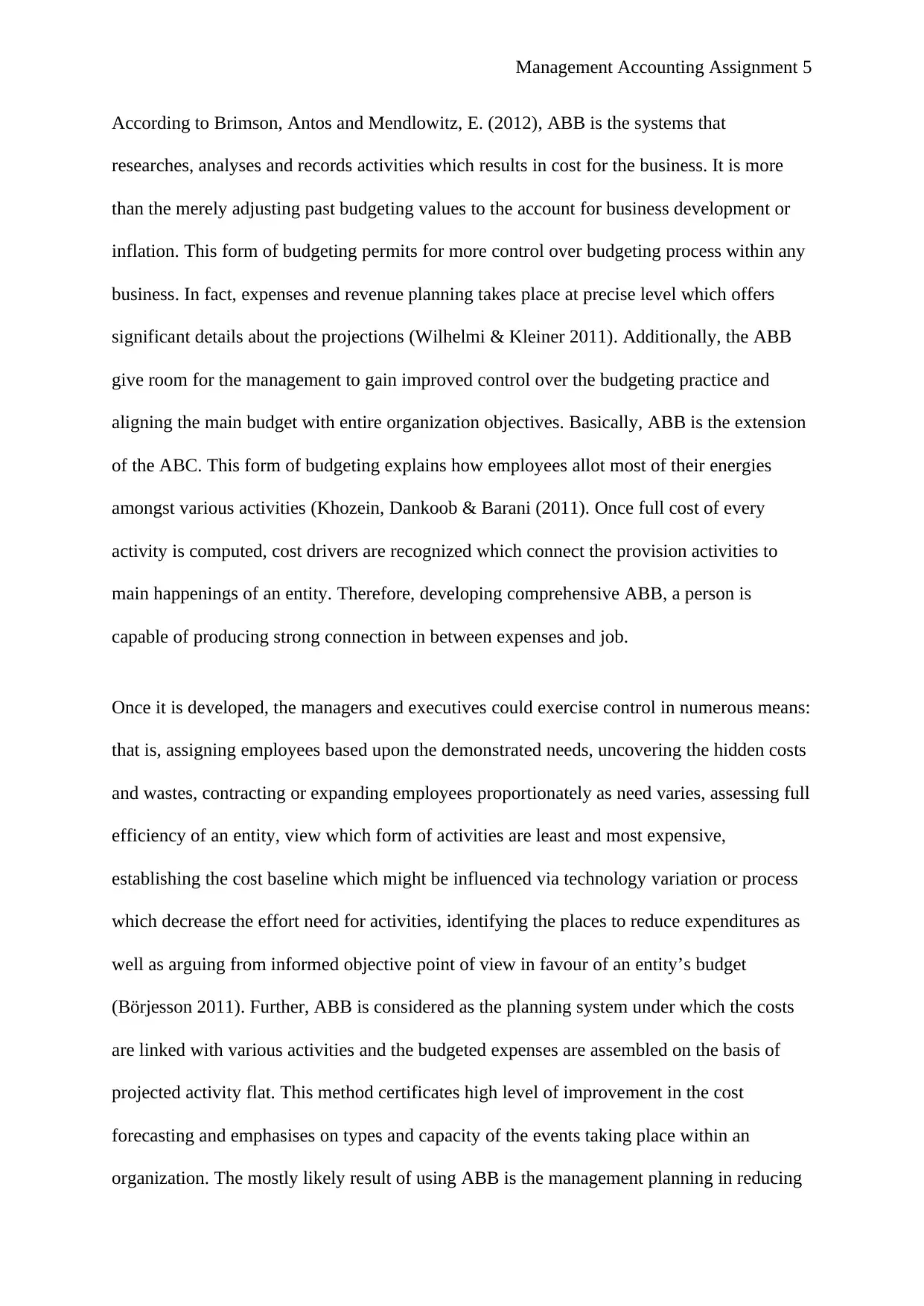
Management Accounting Assignment 5
According to Brimson, Antos and Mendlowitz, E. (2012), ABB is the systems that
researches, analyses and records activities which results in cost for the business. It is more
than the merely adjusting past budgeting values to the account for business development or
inflation. This form of budgeting permits for more control over budgeting process within any
business. In fact, expenses and revenue planning takes place at precise level which offers
significant details about the projections (Wilhelmi & Kleiner 2011). Additionally, the ABB
give room for the management to gain improved control over the budgeting practice and
aligning the main budget with entire organization objectives. Basically, ABB is the extension
of the ABC. This form of budgeting explains how employees allot most of their energies
amongst various activities (Khozein, Dankoob & Barani (2011). Once full cost of every
activity is computed, cost drivers are recognized which connect the provision activities to
main happenings of an entity. Therefore, developing comprehensive ABB, a person is
capable of producing strong connection in between expenses and job.
Once it is developed, the managers and executives could exercise control in numerous means:
that is, assigning employees based upon the demonstrated needs, uncovering the hidden costs
and wastes, contracting or expanding employees proportionately as need varies, assessing full
efficiency of an entity, view which form of activities are least and most expensive,
establishing the cost baseline which might be influenced via technology variation or process
which decrease the effort need for activities, identifying the places to reduce expenditures as
well as arguing from informed objective point of view in favour of an entity’s budget
(Börjesson 2011). Further, ABB is considered as the planning system under which the costs
are linked with various activities and the budgeted expenses are assembled on the basis of
projected activity flat. This method certificates high level of improvement in the cost
forecasting and emphasises on types and capacity of the events taking place within an
organization. The mostly likely result of using ABB is the management planning in reducing
According to Brimson, Antos and Mendlowitz, E. (2012), ABB is the systems that
researches, analyses and records activities which results in cost for the business. It is more
than the merely adjusting past budgeting values to the account for business development or
inflation. This form of budgeting permits for more control over budgeting process within any
business. In fact, expenses and revenue planning takes place at precise level which offers
significant details about the projections (Wilhelmi & Kleiner 2011). Additionally, the ABB
give room for the management to gain improved control over the budgeting practice and
aligning the main budget with entire organization objectives. Basically, ABB is the extension
of the ABC. This form of budgeting explains how employees allot most of their energies
amongst various activities (Khozein, Dankoob & Barani (2011). Once full cost of every
activity is computed, cost drivers are recognized which connect the provision activities to
main happenings of an entity. Therefore, developing comprehensive ABB, a person is
capable of producing strong connection in between expenses and job.
Once it is developed, the managers and executives could exercise control in numerous means:
that is, assigning employees based upon the demonstrated needs, uncovering the hidden costs
and wastes, contracting or expanding employees proportionately as need varies, assessing full
efficiency of an entity, view which form of activities are least and most expensive,
establishing the cost baseline which might be influenced via technology variation or process
which decrease the effort need for activities, identifying the places to reduce expenditures as
well as arguing from informed objective point of view in favour of an entity’s budget
(Börjesson 2011). Further, ABB is considered as the planning system under which the costs
are linked with various activities and the budgeted expenses are assembled on the basis of
projected activity flat. This method certificates high level of improvement in the cost
forecasting and emphasises on types and capacity of the events taking place within an
organization. The mostly likely result of using ABB is the management planning in reducing
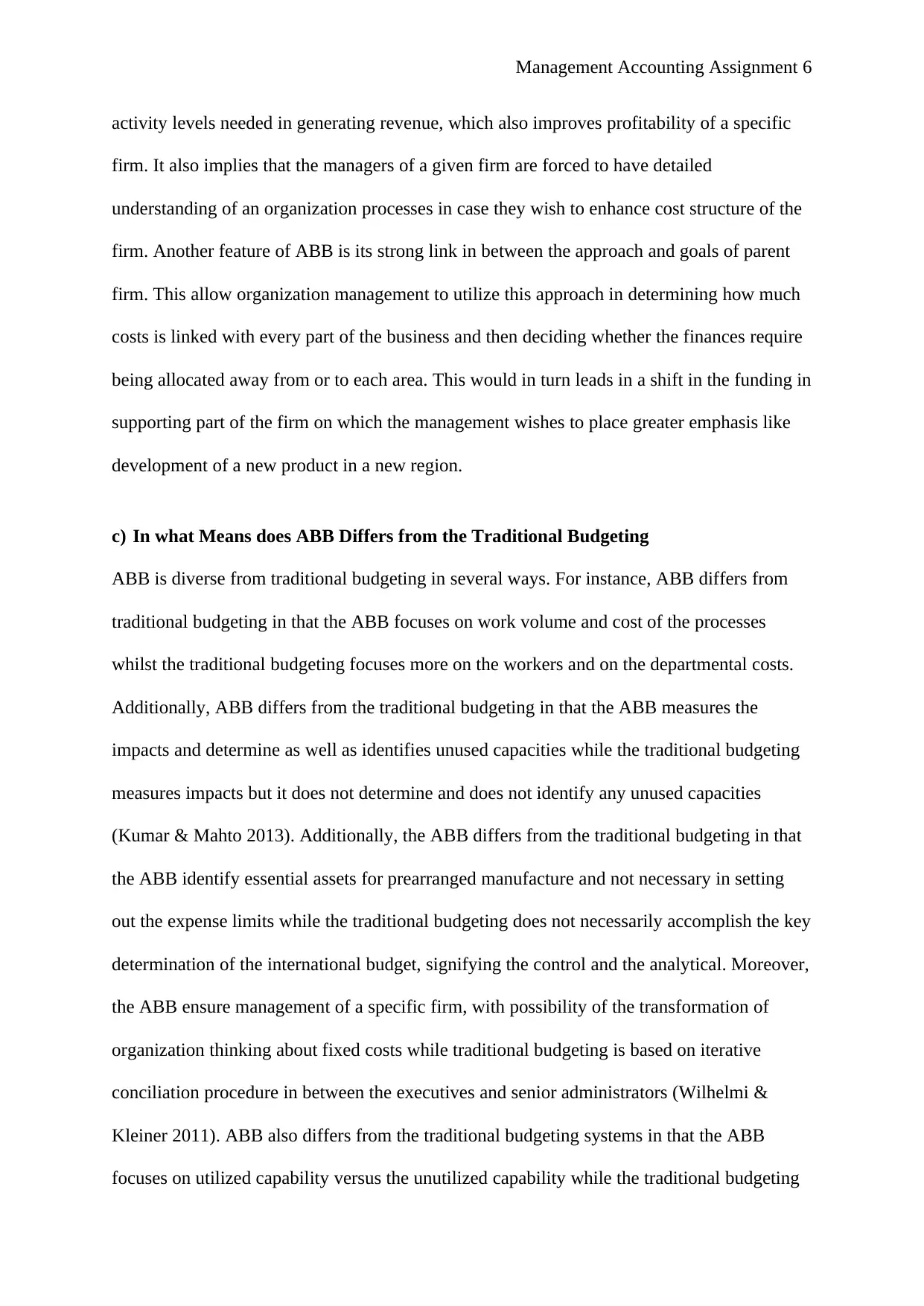
Management Accounting Assignment 6
activity levels needed in generating revenue, which also improves profitability of a specific
firm. It also implies that the managers of a given firm are forced to have detailed
understanding of an organization processes in case they wish to enhance cost structure of the
firm. Another feature of ABB is its strong link in between the approach and goals of parent
firm. This allow organization management to utilize this approach in determining how much
costs is linked with every part of the business and then deciding whether the finances require
being allocated away from or to each area. This would in turn leads in a shift in the funding in
supporting part of the firm on which the management wishes to place greater emphasis like
development of a new product in a new region.
c) In what Means does ABB Differs from the Traditional Budgeting
ABB is diverse from traditional budgeting in several ways. For instance, ABB differs from
traditional budgeting in that the ABB focuses on work volume and cost of the processes
whilst the traditional budgeting focuses more on the workers and on the departmental costs.
Additionally, ABB differs from the traditional budgeting in that the ABB measures the
impacts and determine as well as identifies unused capacities while the traditional budgeting
measures impacts but it does not determine and does not identify any unused capacities
(Kumar & Mahto 2013). Additionally, the ABB differs from the traditional budgeting in that
the ABB identify essential assets for prearranged manufacture and not necessary in setting
out the expense limits while the traditional budgeting does not necessarily accomplish the key
determination of the international budget, signifying the control and the analytical. Moreover,
the ABB ensure management of a specific firm, with possibility of the transformation of
organization thinking about fixed costs while traditional budgeting is based on iterative
conciliation procedure in between the executives and senior administrators (Wilhelmi &
Kleiner 2011). ABB also differs from the traditional budgeting systems in that the ABB
focuses on utilized capability versus the unutilized capability while the traditional budgeting
activity levels needed in generating revenue, which also improves profitability of a specific
firm. It also implies that the managers of a given firm are forced to have detailed
understanding of an organization processes in case they wish to enhance cost structure of the
firm. Another feature of ABB is its strong link in between the approach and goals of parent
firm. This allow organization management to utilize this approach in determining how much
costs is linked with every part of the business and then deciding whether the finances require
being allocated away from or to each area. This would in turn leads in a shift in the funding in
supporting part of the firm on which the management wishes to place greater emphasis like
development of a new product in a new region.
c) In what Means does ABB Differs from the Traditional Budgeting
ABB is diverse from traditional budgeting in several ways. For instance, ABB differs from
traditional budgeting in that the ABB focuses on work volume and cost of the processes
whilst the traditional budgeting focuses more on the workers and on the departmental costs.
Additionally, ABB differs from the traditional budgeting in that the ABB measures the
impacts and determine as well as identifies unused capacities while the traditional budgeting
measures impacts but it does not determine and does not identify any unused capacities
(Kumar & Mahto 2013). Additionally, the ABB differs from the traditional budgeting in that
the ABB identify essential assets for prearranged manufacture and not necessary in setting
out the expense limits while the traditional budgeting does not necessarily accomplish the key
determination of the international budget, signifying the control and the analytical. Moreover,
the ABB ensure management of a specific firm, with possibility of the transformation of
organization thinking about fixed costs while traditional budgeting is based on iterative
conciliation procedure in between the executives and senior administrators (Wilhelmi &
Kleiner 2011). ABB also differs from the traditional budgeting systems in that the ABB
focuses on utilized capability versus the unutilized capability while the traditional budgeting
⊘ This is a preview!⊘
Do you want full access?
Subscribe today to unlock all pages.

Trusted by 1+ million students worldwide
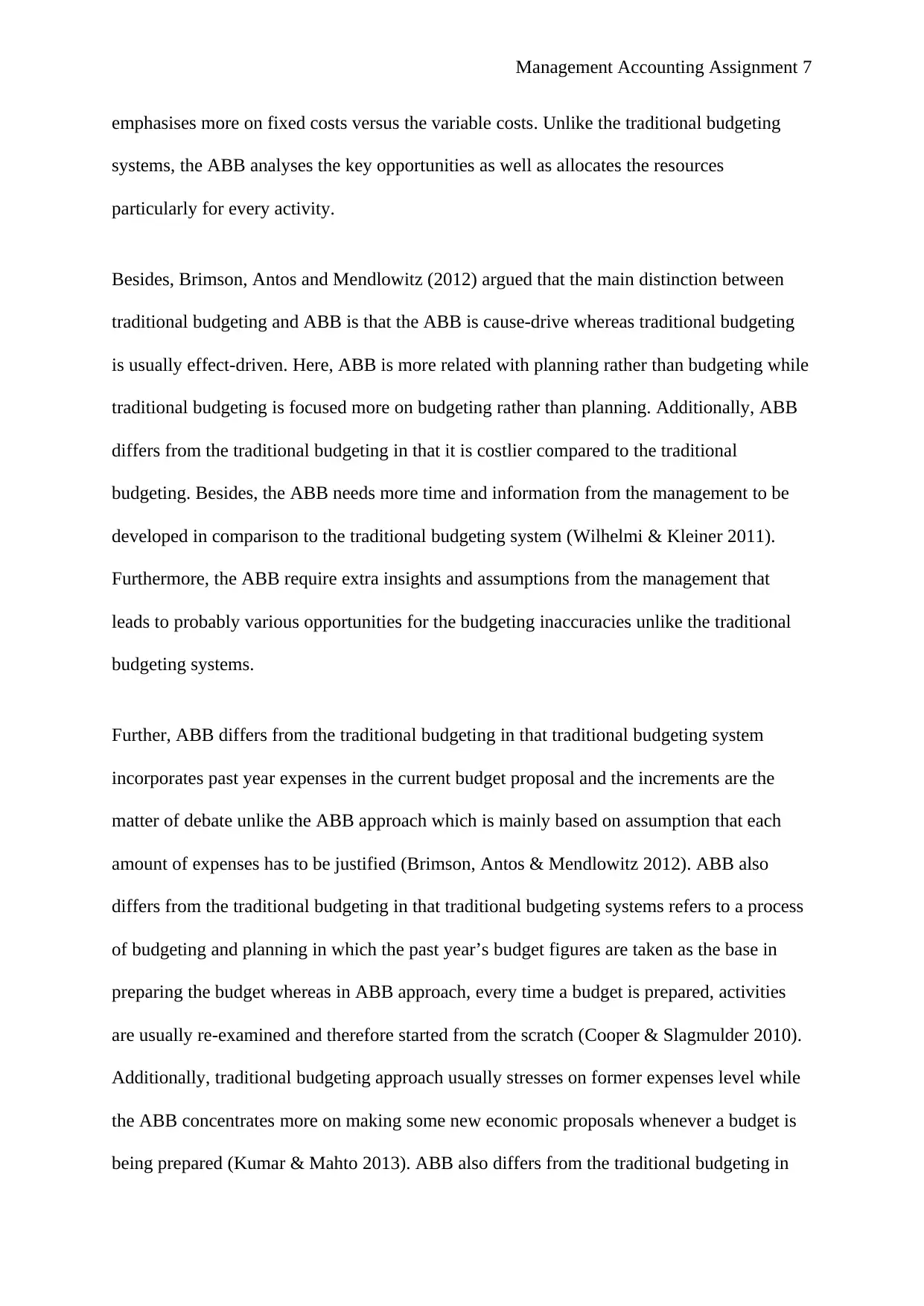
Management Accounting Assignment 7
emphasises more on fixed costs versus the variable costs. Unlike the traditional budgeting
systems, the ABB analyses the key opportunities as well as allocates the resources
particularly for every activity.
Besides, Brimson, Antos and Mendlowitz (2012) argued that the main distinction between
traditional budgeting and ABB is that the ABB is cause-drive whereas traditional budgeting
is usually effect-driven. Here, ABB is more related with planning rather than budgeting while
traditional budgeting is focused more on budgeting rather than planning. Additionally, ABB
differs from the traditional budgeting in that it is costlier compared to the traditional
budgeting. Besides, the ABB needs more time and information from the management to be
developed in comparison to the traditional budgeting system (Wilhelmi & Kleiner 2011).
Furthermore, the ABB require extra insights and assumptions from the management that
leads to probably various opportunities for the budgeting inaccuracies unlike the traditional
budgeting systems.
Further, ABB differs from the traditional budgeting in that traditional budgeting system
incorporates past year expenses in the current budget proposal and the increments are the
matter of debate unlike the ABB approach which is mainly based on assumption that each
amount of expenses has to be justified (Brimson, Antos & Mendlowitz 2012). ABB also
differs from the traditional budgeting in that traditional budgeting systems refers to a process
of budgeting and planning in which the past year’s budget figures are taken as the base in
preparing the budget whereas in ABB approach, every time a budget is prepared, activities
are usually re-examined and therefore started from the scratch (Cooper & Slagmulder 2010).
Additionally, traditional budgeting approach usually stresses on former expenses level while
the ABB concentrates more on making some new economic proposals whenever a budget is
being prepared (Kumar & Mahto 2013). ABB also differs from the traditional budgeting in
emphasises more on fixed costs versus the variable costs. Unlike the traditional budgeting
systems, the ABB analyses the key opportunities as well as allocates the resources
particularly for every activity.
Besides, Brimson, Antos and Mendlowitz (2012) argued that the main distinction between
traditional budgeting and ABB is that the ABB is cause-drive whereas traditional budgeting
is usually effect-driven. Here, ABB is more related with planning rather than budgeting while
traditional budgeting is focused more on budgeting rather than planning. Additionally, ABB
differs from the traditional budgeting in that it is costlier compared to the traditional
budgeting. Besides, the ABB needs more time and information from the management to be
developed in comparison to the traditional budgeting system (Wilhelmi & Kleiner 2011).
Furthermore, the ABB require extra insights and assumptions from the management that
leads to probably various opportunities for the budgeting inaccuracies unlike the traditional
budgeting systems.
Further, ABB differs from the traditional budgeting in that traditional budgeting system
incorporates past year expenses in the current budget proposal and the increments are the
matter of debate unlike the ABB approach which is mainly based on assumption that each
amount of expenses has to be justified (Brimson, Antos & Mendlowitz 2012). ABB also
differs from the traditional budgeting in that traditional budgeting systems refers to a process
of budgeting and planning in which the past year’s budget figures are taken as the base in
preparing the budget whereas in ABB approach, every time a budget is prepared, activities
are usually re-examined and therefore started from the scratch (Cooper & Slagmulder 2010).
Additionally, traditional budgeting approach usually stresses on former expenses level while
the ABB concentrates more on making some new economic proposals whenever a budget is
being prepared (Kumar & Mahto 2013). ABB also differs from the traditional budgeting in
Paraphrase This Document
Need a fresh take? Get an instant paraphrase of this document with our AI Paraphraser
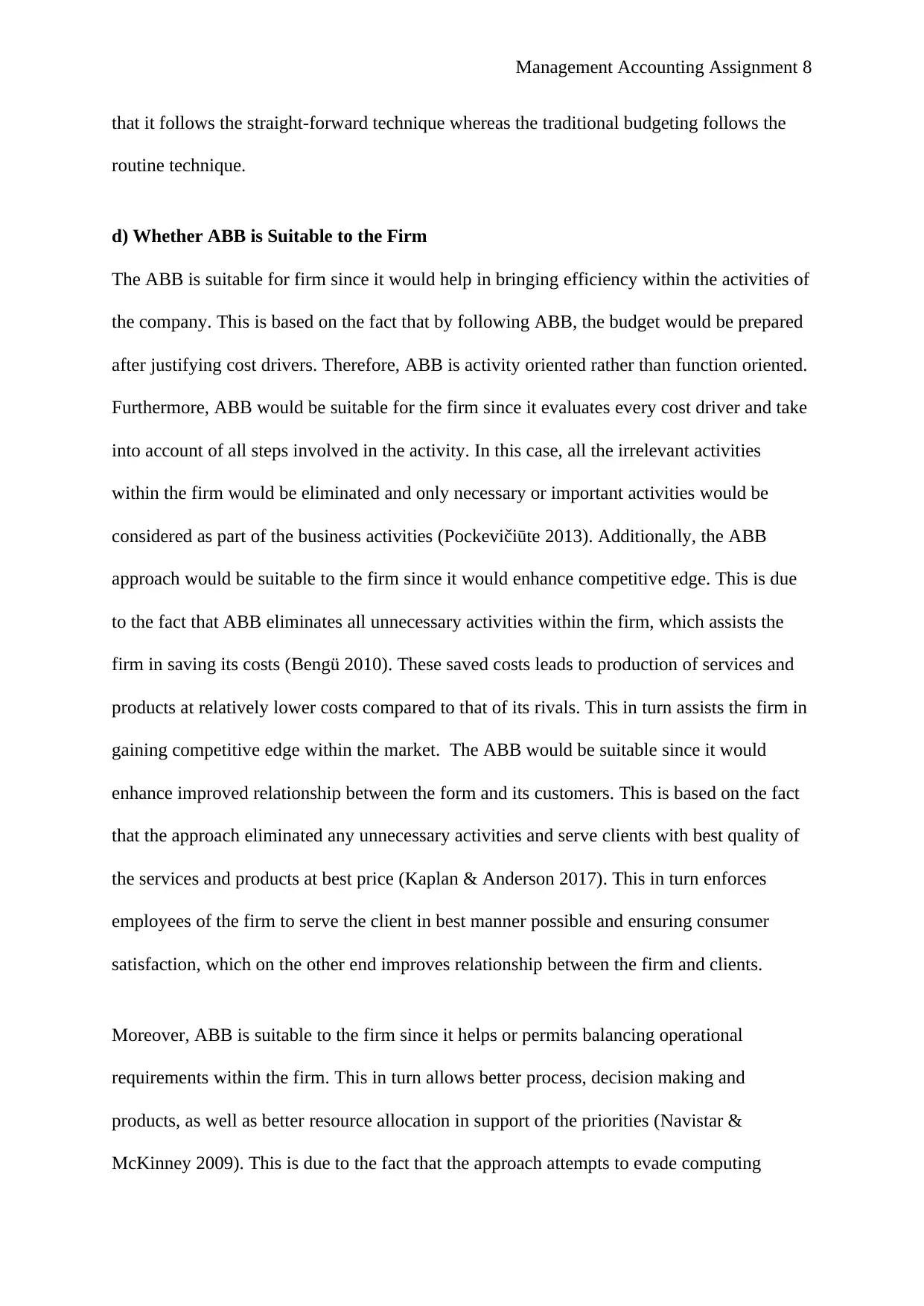
Management Accounting Assignment 8
that it follows the straight-forward technique whereas the traditional budgeting follows the
routine technique.
d) Whether ABB is Suitable to the Firm
The ABB is suitable for firm since it would help in bringing efficiency within the activities of
the company. This is based on the fact that by following ABB, the budget would be prepared
after justifying cost drivers. Therefore, ABB is activity oriented rather than function oriented.
Furthermore, ABB would be suitable for the firm since it evaluates every cost driver and take
into account of all steps involved in the activity. In this case, all the irrelevant activities
within the firm would be eliminated and only necessary or important activities would be
considered as part of the business activities (Pockevičiūte 2013). Additionally, the ABB
approach would be suitable to the firm since it would enhance competitive edge. This is due
to the fact that ABB eliminates all unnecessary activities within the firm, which assists the
firm in saving its costs (Bengü 2010). These saved costs leads to production of services and
products at relatively lower costs compared to that of its rivals. This in turn assists the firm in
gaining competitive edge within the market. The ABB would be suitable since it would
enhance improved relationship between the form and its customers. This is based on the fact
that the approach eliminated any unnecessary activities and serve clients with best quality of
the services and products at best price (Kaplan & Anderson 2017). This in turn enforces
employees of the firm to serve the client in best manner possible and ensuring consumer
satisfaction, which on the other end improves relationship between the firm and clients.
Moreover, ABB is suitable to the firm since it helps or permits balancing operational
requirements within the firm. This in turn allows better process, decision making and
products, as well as better resource allocation in support of the priorities (Navistar &
McKinney 2009). This is due to the fact that the approach attempts to evade computing
that it follows the straight-forward technique whereas the traditional budgeting follows the
routine technique.
d) Whether ABB is Suitable to the Firm
The ABB is suitable for firm since it would help in bringing efficiency within the activities of
the company. This is based on the fact that by following ABB, the budget would be prepared
after justifying cost drivers. Therefore, ABB is activity oriented rather than function oriented.
Furthermore, ABB would be suitable for the firm since it evaluates every cost driver and take
into account of all steps involved in the activity. In this case, all the irrelevant activities
within the firm would be eliminated and only necessary or important activities would be
considered as part of the business activities (Pockevičiūte 2013). Additionally, the ABB
approach would be suitable to the firm since it would enhance competitive edge. This is due
to the fact that ABB eliminates all unnecessary activities within the firm, which assists the
firm in saving its costs (Bengü 2010). These saved costs leads to production of services and
products at relatively lower costs compared to that of its rivals. This in turn assists the firm in
gaining competitive edge within the market. The ABB would be suitable since it would
enhance improved relationship between the form and its customers. This is based on the fact
that the approach eliminated any unnecessary activities and serve clients with best quality of
the services and products at best price (Kaplan & Anderson 2017). This in turn enforces
employees of the firm to serve the client in best manner possible and ensuring consumer
satisfaction, which on the other end improves relationship between the firm and clients.
Moreover, ABB is suitable to the firm since it helps or permits balancing operational
requirements within the firm. This in turn allows better process, decision making and
products, as well as better resource allocation in support of the priorities (Navistar &
McKinney 2009). This is due to the fact that the approach attempts to evade computing
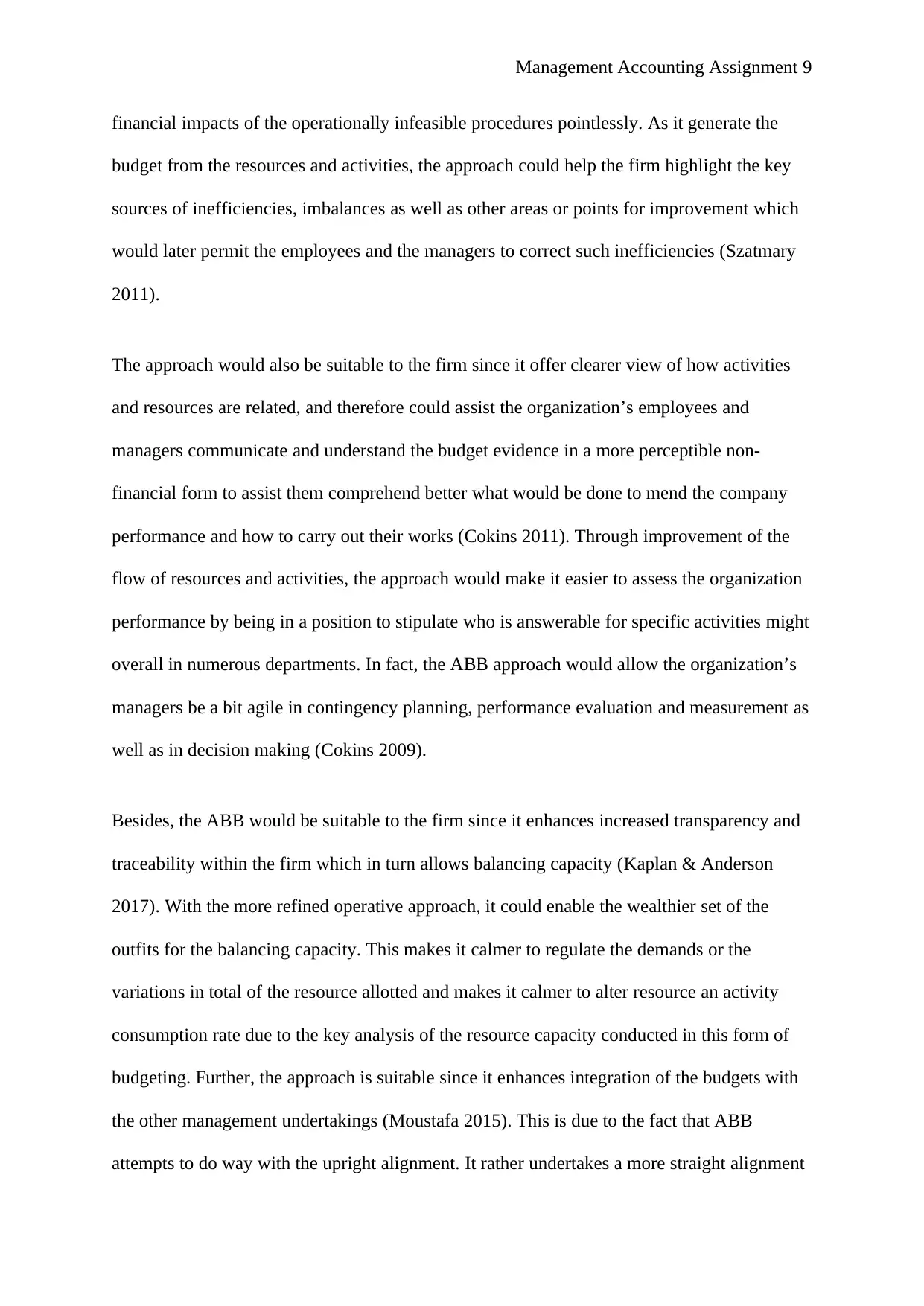
Management Accounting Assignment 9
financial impacts of the operationally infeasible procedures pointlessly. As it generate the
budget from the resources and activities, the approach could help the firm highlight the key
sources of inefficiencies, imbalances as well as other areas or points for improvement which
would later permit the employees and the managers to correct such inefficiencies (Szatmary
2011).
The approach would also be suitable to the firm since it offer clearer view of how activities
and resources are related, and therefore could assist the organization’s employees and
managers communicate and understand the budget evidence in a more perceptible non-
financial form to assist them comprehend better what would be done to mend the company
performance and how to carry out their works (Cokins 2011). Through improvement of the
flow of resources and activities, the approach would make it easier to assess the organization
performance by being in a position to stipulate who is answerable for specific activities might
overall in numerous departments. In fact, the ABB approach would allow the organization’s
managers be a bit agile in contingency planning, performance evaluation and measurement as
well as in decision making (Cokins 2009).
Besides, the ABB would be suitable to the firm since it enhances increased transparency and
traceability within the firm which in turn allows balancing capacity (Kaplan & Anderson
2017). With the more refined operative approach, it could enable the wealthier set of the
outfits for the balancing capacity. This makes it calmer to regulate the demands or the
variations in total of the resource allotted and makes it calmer to alter resource an activity
consumption rate due to the key analysis of the resource capacity conducted in this form of
budgeting. Further, the approach is suitable since it enhances integration of the budgets with
the other management undertakings (Moustafa 2015). This is due to the fact that ABB
attempts to do way with the upright alignment. It rather undertakes a more straight alignment
financial impacts of the operationally infeasible procedures pointlessly. As it generate the
budget from the resources and activities, the approach could help the firm highlight the key
sources of inefficiencies, imbalances as well as other areas or points for improvement which
would later permit the employees and the managers to correct such inefficiencies (Szatmary
2011).
The approach would also be suitable to the firm since it offer clearer view of how activities
and resources are related, and therefore could assist the organization’s employees and
managers communicate and understand the budget evidence in a more perceptible non-
financial form to assist them comprehend better what would be done to mend the company
performance and how to carry out their works (Cokins 2011). Through improvement of the
flow of resources and activities, the approach would make it easier to assess the organization
performance by being in a position to stipulate who is answerable for specific activities might
overall in numerous departments. In fact, the ABB approach would allow the organization’s
managers be a bit agile in contingency planning, performance evaluation and measurement as
well as in decision making (Cokins 2009).
Besides, the ABB would be suitable to the firm since it enhances increased transparency and
traceability within the firm which in turn allows balancing capacity (Kaplan & Anderson
2017). With the more refined operative approach, it could enable the wealthier set of the
outfits for the balancing capacity. This makes it calmer to regulate the demands or the
variations in total of the resource allotted and makes it calmer to alter resource an activity
consumption rate due to the key analysis of the resource capacity conducted in this form of
budgeting. Further, the approach is suitable since it enhances integration of the budgets with
the other management undertakings (Moustafa 2015). This is due to the fact that ABB
attempts to do way with the upright alignment. It rather undertakes a more straight alignment
⊘ This is a preview!⊘
Do you want full access?
Subscribe today to unlock all pages.

Trusted by 1+ million students worldwide
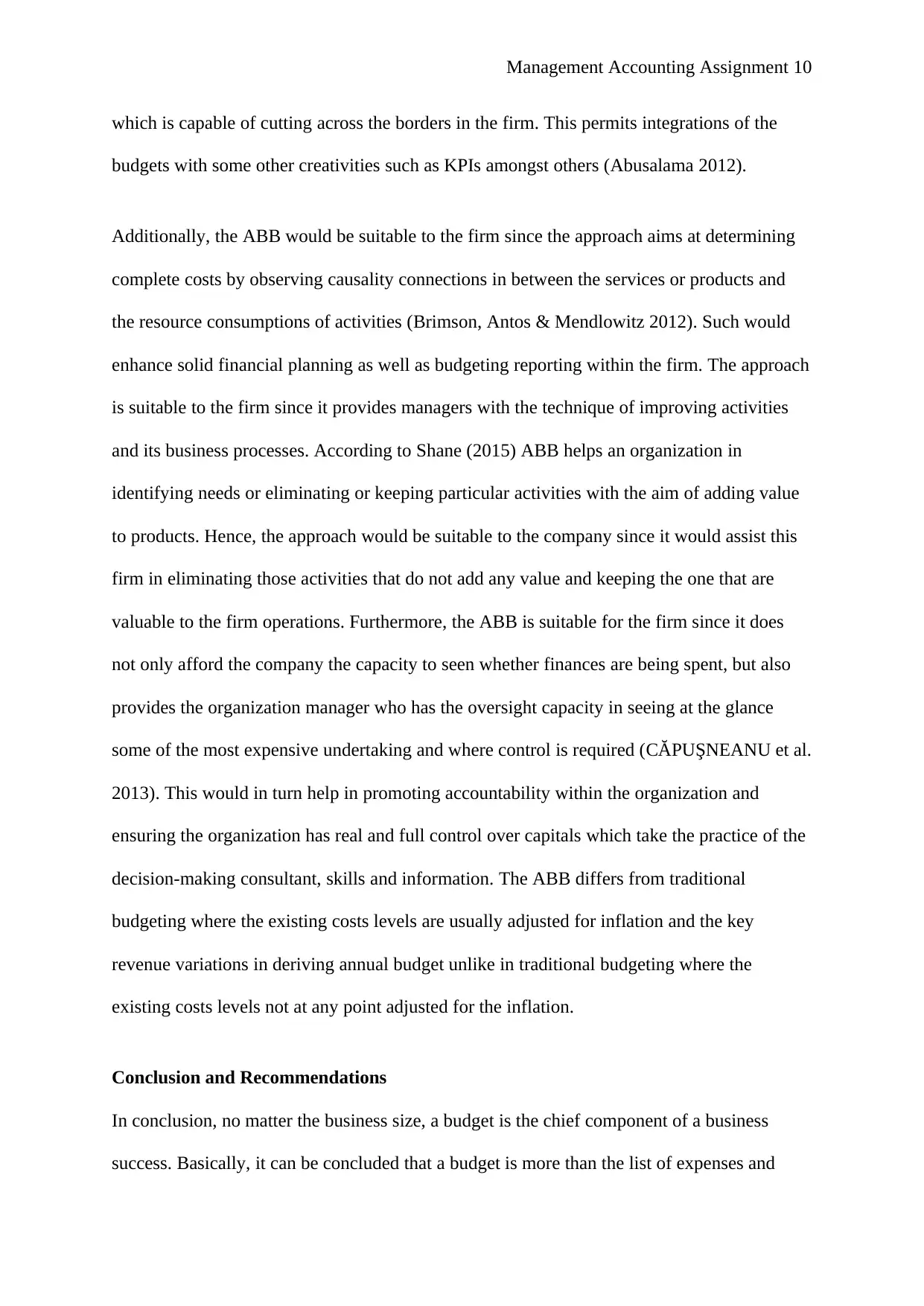
Management Accounting Assignment 10
which is capable of cutting across the borders in the firm. This permits integrations of the
budgets with some other creativities such as KPIs amongst others (Abusalama 2012).
Additionally, the ABB would be suitable to the firm since the approach aims at determining
complete costs by observing causality connections in between the services or products and
the resource consumptions of activities (Brimson, Antos & Mendlowitz 2012). Such would
enhance solid financial planning as well as budgeting reporting within the firm. The approach
is suitable to the firm since it provides managers with the technique of improving activities
and its business processes. According to Shane (2015) ABB helps an organization in
identifying needs or eliminating or keeping particular activities with the aim of adding value
to products. Hence, the approach would be suitable to the company since it would assist this
firm in eliminating those activities that do not add any value and keeping the one that are
valuable to the firm operations. Furthermore, the ABB is suitable for the firm since it does
not only afford the company the capacity to seen whether finances are being spent, but also
provides the organization manager who has the oversight capacity in seeing at the glance
some of the most expensive undertaking and where control is required (CĂPUŞNEANU et al.
2013). This would in turn help in promoting accountability within the organization and
ensuring the organization has real and full control over capitals which take the practice of the
decision-making consultant, skills and information. The ABB differs from traditional
budgeting where the existing costs levels are usually adjusted for inflation and the key
revenue variations in deriving annual budget unlike in traditional budgeting where the
existing costs levels not at any point adjusted for the inflation.
Conclusion and Recommendations
In conclusion, no matter the business size, a budget is the chief component of a business
success. Basically, it can be concluded that a budget is more than the list of expenses and
which is capable of cutting across the borders in the firm. This permits integrations of the
budgets with some other creativities such as KPIs amongst others (Abusalama 2012).
Additionally, the ABB would be suitable to the firm since the approach aims at determining
complete costs by observing causality connections in between the services or products and
the resource consumptions of activities (Brimson, Antos & Mendlowitz 2012). Such would
enhance solid financial planning as well as budgeting reporting within the firm. The approach
is suitable to the firm since it provides managers with the technique of improving activities
and its business processes. According to Shane (2015) ABB helps an organization in
identifying needs or eliminating or keeping particular activities with the aim of adding value
to products. Hence, the approach would be suitable to the company since it would assist this
firm in eliminating those activities that do not add any value and keeping the one that are
valuable to the firm operations. Furthermore, the ABB is suitable for the firm since it does
not only afford the company the capacity to seen whether finances are being spent, but also
provides the organization manager who has the oversight capacity in seeing at the glance
some of the most expensive undertaking and where control is required (CĂPUŞNEANU et al.
2013). This would in turn help in promoting accountability within the organization and
ensuring the organization has real and full control over capitals which take the practice of the
decision-making consultant, skills and information. The ABB differs from traditional
budgeting where the existing costs levels are usually adjusted for inflation and the key
revenue variations in deriving annual budget unlike in traditional budgeting where the
existing costs levels not at any point adjusted for the inflation.
Conclusion and Recommendations
In conclusion, no matter the business size, a budget is the chief component of a business
success. Basically, it can be concluded that a budget is more than the list of expenses and
Paraphrase This Document
Need a fresh take? Get an instant paraphrase of this document with our AI Paraphraser
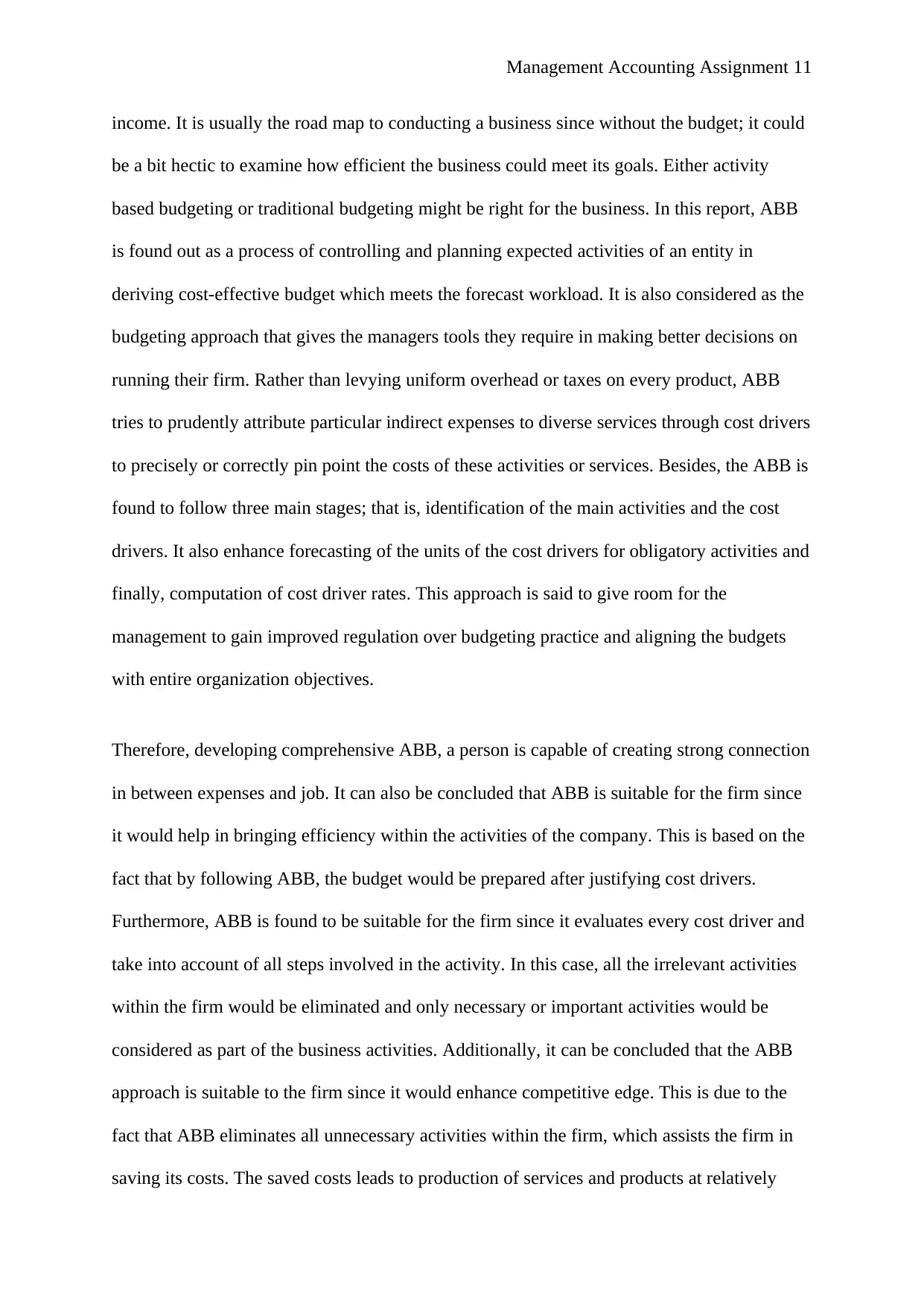
Management Accounting Assignment 11
income. It is usually the road map to conducting a business since without the budget; it could
be a bit hectic to examine how efficient the business could meet its goals. Either activity
based budgeting or traditional budgeting might be right for the business. In this report, ABB
is found out as a process of controlling and planning expected activities of an entity in
deriving cost-effective budget which meets the forecast workload. It is also considered as the
budgeting approach that gives the managers tools they require in making better decisions on
running their firm. Rather than levying uniform overhead or taxes on every product, ABB
tries to prudently attribute particular indirect expenses to diverse services through cost drivers
to precisely or correctly pin point the costs of these activities or services. Besides, the ABB is
found to follow three main stages; that is, identification of the main activities and the cost
drivers. It also enhance forecasting of the units of the cost drivers for obligatory activities and
finally, computation of cost driver rates. This approach is said to give room for the
management to gain improved regulation over budgeting practice and aligning the budgets
with entire organization objectives.
Therefore, developing comprehensive ABB, a person is capable of creating strong connection
in between expenses and job. It can also be concluded that ABB is suitable for the firm since
it would help in bringing efficiency within the activities of the company. This is based on the
fact that by following ABB, the budget would be prepared after justifying cost drivers.
Furthermore, ABB is found to be suitable for the firm since it evaluates every cost driver and
take into account of all steps involved in the activity. In this case, all the irrelevant activities
within the firm would be eliminated and only necessary or important activities would be
considered as part of the business activities. Additionally, it can be concluded that the ABB
approach is suitable to the firm since it would enhance competitive edge. This is due to the
fact that ABB eliminates all unnecessary activities within the firm, which assists the firm in
saving its costs. The saved costs leads to production of services and products at relatively
income. It is usually the road map to conducting a business since without the budget; it could
be a bit hectic to examine how efficient the business could meet its goals. Either activity
based budgeting or traditional budgeting might be right for the business. In this report, ABB
is found out as a process of controlling and planning expected activities of an entity in
deriving cost-effective budget which meets the forecast workload. It is also considered as the
budgeting approach that gives the managers tools they require in making better decisions on
running their firm. Rather than levying uniform overhead or taxes on every product, ABB
tries to prudently attribute particular indirect expenses to diverse services through cost drivers
to precisely or correctly pin point the costs of these activities or services. Besides, the ABB is
found to follow three main stages; that is, identification of the main activities and the cost
drivers. It also enhance forecasting of the units of the cost drivers for obligatory activities and
finally, computation of cost driver rates. This approach is said to give room for the
management to gain improved regulation over budgeting practice and aligning the budgets
with entire organization objectives.
Therefore, developing comprehensive ABB, a person is capable of creating strong connection
in between expenses and job. It can also be concluded that ABB is suitable for the firm since
it would help in bringing efficiency within the activities of the company. This is based on the
fact that by following ABB, the budget would be prepared after justifying cost drivers.
Furthermore, ABB is found to be suitable for the firm since it evaluates every cost driver and
take into account of all steps involved in the activity. In this case, all the irrelevant activities
within the firm would be eliminated and only necessary or important activities would be
considered as part of the business activities. Additionally, it can be concluded that the ABB
approach is suitable to the firm since it would enhance competitive edge. This is due to the
fact that ABB eliminates all unnecessary activities within the firm, which assists the firm in
saving its costs. The saved costs leads to production of services and products at relatively

Management Accounting Assignment 12
lower costs compared to that of its rivals. This in turn assists the firm in gaining competitive
edge within the market. Therefore, it would be recommendable for the firm to implement
ABB as their chief budgeting technique which would enhance balancing operational
requirements within the firm. This would in turn allows better process, decision making and
products, as well as better resource allocation in support of the priorities within the firm.
lower costs compared to that of its rivals. This in turn assists the firm in gaining competitive
edge within the market. Therefore, it would be recommendable for the firm to implement
ABB as their chief budgeting technique which would enhance balancing operational
requirements within the firm. This would in turn allows better process, decision making and
products, as well as better resource allocation in support of the priorities within the firm.
⊘ This is a preview!⊘
Do you want full access?
Subscribe today to unlock all pages.

Trusted by 1+ million students worldwide
1 out of 15
Related Documents
Your All-in-One AI-Powered Toolkit for Academic Success.
+13062052269
info@desklib.com
Available 24*7 on WhatsApp / Email
![[object Object]](/_next/static/media/star-bottom.7253800d.svg)
Unlock your academic potential
Copyright © 2020–2025 A2Z Services. All Rights Reserved. Developed and managed by ZUCOL.





